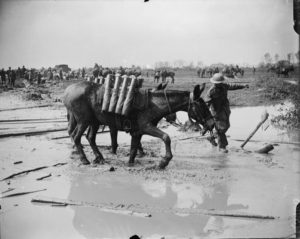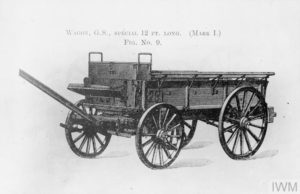Wednesday May 1st, 1918
Very hot day. We are to be relieved tonight by the South Lancs and we go to Shelter Ravine again. Left Bowls Barrow Camp 8:30. Raining hard and pitch dark. Much work loading machine gun mules. Arrived at Shelter Ravine 11:30 wet through and tired.
Shelter Ravine

Tonight the Battalion is being relieved by the 9th South Lancs. Frank helps prepare for the move by loading the Lewis Guns onto the mules. Each company has been allocated 10 mules for its machine guns. The photograph shows mules carrying munitions across a muddy and waterlogged field.
The new limbers seem to have been given to B and C companies and the Battalion HQ, each of which now has four. The limbers are being used to move blankets, company stores and officers’ and men’s kits. Each limber is pulled by two animals and carries the equivalent of the burden of four mules. A and D companies, with approximately 250 men, have 39 mules each to help them move.
Frank says they are going to Shelter Ravine again. B Company was actually camped in Gun Ravine (just behind Shelter Ravine) while the other three companies and Battalion HQ were in Saida. This time B Company will be in reserve, but it looks like their camp will again be in Gun Ravine.
Accident & Fall Back
The fall back from the front line was carefully orchestrated by the Battalion Commander, Lt Colonel Morrell, and the 13th is instructed to man sections of the second line of defences from Q10 to R 26 until the 9th has control of it. ‘Companies are to march off independently to camps at Saida, as soon as the positions in the second Line have been occupied to the satisfaction of the Company Commanders.’¹

Both Frank and the Battalion talk about the rain storm and the pitch dark of the evening. Unfortunately this means that the 13th’s General Service Wagon and the 9th South Lancs’ Maltese Cart fall down a ravine. There is no mention of casualties – just that it caused a delay.
General Service Wagons were drawn by two horses and used by the British and Dominion Armies throughout the war. They had been in service since 1862. By 1905, the wagon had been modified several times and evolved to the Mark X. Eventually it would be replaced by motorized transport between the First and Second World War. As its name suggest it was a general purpose vehicle and used mainly for moving equipment and supplies. It was rugged and well suited to the varied terrain of Macedonia.
Ref Maps Dojran Edn 3A 1:20,000; Kilindir 1:20,000 & Pobreg 1:20,000
13th (Service) Battalion War Diary – 1st May 1918 – Crow Hill
Artillery activity on both sides quieter than usual. The Battalion was relieved in the line by the 9th South Lancs who moved in and established the new sector headquarters at Sporan Hill. A company of the Battalion in Brigade reserve will move into Crow Hill. A rain storm in the evening caused considerable delay in the relief, the night was so dark it was difficult to get about. Our GS wagon and the Maltese Cart of the 9th South Lancs both fell down a ravine, and helped to delay matters. The relief was eventually completed by 23:50 hrs and the Battalion moved out to Saida manning the second line trenches on the way. The Battalion was reported present in the new camps by 2:30 hrs on the 2-5-18 and became Divisional Reserve.
References & Further Reading
¹ BWD April 1918, Appendix 6, Operation Order No 36.
* Q65477 copyright Imperial War Museums


